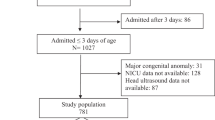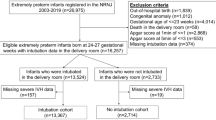Abstract
Objective:
The purpose of this study was to evaluate the relationship between intraventricular hemorrhage (IVH), inter-hospital transport and known potential risk factors for IVH.
Study Design:
Very low birth weight (VLBW <1500 g) infants admitted to a large regional neonatal intensive care unit within 48 h of life from 2005 to 2010 were identified. Logistic regression and proportional odds logistic regression models were used to compare inborn versus outborn patients with respect to IVH (any vs none) and IVH grade, respectively. Logistic regression was used to quantify the association between outborn status and mortality.
Result:
A total of 758 infants were included in the study (inborn=568, outborn=190). Outborn infants were found to have greater IVH severity than inborn (odds ratio (OR): 1.52; P=0.012). After accounting for 20 clinical and demographic variables in a multivariable model, the association between outborn status and IVH lacked statistical significance (OR: 1.14; P=0.56). Significant predictors of IVH grade included vaginal delivery (OR: 2.16; P<0.001), patent ductus arteriosus (OR: 1.65; P=0.005), 5-min Apgar (OR: 0.85; P=0.005) and gestational age (OR: 0.98; P=0.012). Sixty-nine (9.1%) of the infants died. After adjusting for potential confounders, the relationship between mortality and outborn status was not significant (OR:1.26; P=0.516). Significant predictors of mortality included gestational age (OR: 1.03; P=0.04) and 5-min Apgar (OR:1.22; P=0.02).
Conclusion:
Although VLBW infants transported during the first 2 days of life have higher rates of IVH than infants born at a tertiary care facility, this relationship may be explained by associations with underlying clinical variables rather than transport itself.
This is a preview of subscription content, access via your institution
Access options
Subscribe to this journal
Receive 12 print issues and online access
$259.00 per year
only $21.58 per issue
Buy this article
- Purchase on Springer Link
- Instant access to full article PDF
Prices may be subject to local taxes which are calculated during checkout

Similar content being viewed by others
References
Hohlagschwandtner M, Husslein P, Klebermass K, Weninger M, Nardi A, Langer M . Perinatal mortality and morbidity. Comparison between maternal transport, neonatal transport and inpatient antenatal treatment. Arch Gynecol Obstet 2001; 265: 113–118.
Mohamed MA, Aly H . Transport of premature infants is associated with increased risk for intraventricular hemorrhage. Arch Dis Child Fetal Neonatal Ed 2010; 95: F403–F407.
Palmer KG, Kronsberg SS, Barton BA, Hobbs CA, Hall RW, Anand KJS . Effect of inborn versus outborn delivery on clinical outcomes on ventilated preterm neonates: secondary results from the NEOPAIN trial. J Perinat 2005; 25: 170–175.
Shlossman PA, Manley JS, Sciscione AC, Colmorgan GH . An analysis of neonatal morbidity and mortality in maternal (in utero) and neonatal transports at 24-34 weeks gestation. Am J Perinatol 1997; 14: 449–456.
Thorp JA, Jones PG, Clark RH, Knox E, Peabody JL . Perinatal factors associated with severe intracranial hemorrhage. Am J Obstet Gynecol 2001; 185: 859–862.
Towers CV, Bonebrake R, Padilla G, Rumney P . The effect of transport on the rate of severe intraventricular hemorrhage in very low birth weight infants. Obstet Gynecol 2000; 95: 291–295.
Yoder BA . Long distance perinatal transport. Am J Perinatol 1992; 9: 75–79.
Alexander JM, Gilstrap LC, Cox SM, McIntire DM, Leveno KJ . Clinical chorioamnionitis and the prognosis for very low birth weight infants. Obstet Gynecol 1998; 91: 725–729.
Hansen A, Leviton A . Labor and delivery characteristics and risks of cranial ultrasonographic abnormalities in very low birth weight infants. Am J Obstet Gynecol 1999; 181: 997–1006.
Shankaran S, Baurer CR, Bain R, Wright LL, Zachary J . Prenatal and perinatal risk and protective factors for neonatal intracranial hemorrhage. Arch Pediatr Adolesc Med 1996; 1150: 491–497.
Synnes AR, Chien LY, Peliowski A, Baboolal R, Lee SK . Variations in intraventricular hemorrhage incidence rates among Canadian neonatal intensive care units. J Pediatr 2001; 138: 525–531.
Verma U, Tejani N, Klein S, Reale MR, Beneck D, Figueroa R et al. Obstetric antecedents of intraventricular hemorrhage and periventricular leukomalacia in the low-birth weight neonate. Am J Obstet Gynecol 1997; 176: 275–281.
Vergani P, Patane L, Doria P, Borroni C, Cappellini A, Pezzullo JC et al. Risk factors for neonatal intraventricular hemorrhage in spontaneous prematurity at 32 weeks gestation or less. Placenta 2000; 21: 402–407.
Egarter C, Leitich H, Karas H, Wieser F, Husslein P, Kaider A et al. Antibiotic treatment in preterm premature rupture of membranes and neonatal morbidity: a metaanalysis. Am J Obstet Gynecol 1996; 174: 589–597.
Gleissner M, Jorch G, Avenarius S . Risk factors for intraventricular hemorrhage in a birth cohort of 3721 premature infants. J Perinat Med 2000; 28: 104–110.
Jim WT, Chiu NC, Chen MR, Hung HY, Kao HA, Hsu CH et al. Cerebral hemodynamic change and intraventricular hemorrhage in very low birth weight infants with patent ductus arteriosus. Ultrasound Med Biol 2005; 31: 197–202.
Stoll BJ, Gordon T, Korones SB, Shankaran S, Tyson JE, Bauer CR et al. Early-onset sepsis in very low birth weight neonates: a report from the National Institute of Child Health and Human Development Neonatal Research Network. J Pediatr 1996; 129: 72–80.
Volpe JJ . Intraventricular hemorrhage in the premature infant: current concepts part II. Ann Neurol 1989; 25: 109–116.
Wells JT, Ment LR . Prevention of intraventricular hemorrhage in preterm infants. Early Hum Dev 1995; 42: 209–233.
Brown DR, Bloom BT, Cohen M, Myers MM, Egan EA, Kattwinkel J et al. Increased survival in low birth weight neonates given prophylactic surfactant. J Perinatol 1998; 18: 431–435.
Crowley P . Prophylactic corticosteroids for preterm birth. Cochrane Database Syst Rev 200 (2): CD000065.
Kresch MJ, Clive JM . Meta-analysis of surfactant replacement therapy if infants with birth weights less than 2000 grams. J Perinatol 1998; 18: 431–435.
Weintraub Z, Solovechick M, Reichman B, Rotschild A, Waisman D, Davkin O et al. Effect of maternal tocolysis on the incidence of severe periventricular/intraventricular haemorrhage in very low birth weight infants. Arch Dis Child Fetal Neonatal Ed 2001; 138: 525–531.
Linder N, Haskin O, Levit O, Klinger G, Prince T, Naor N et al. Risk factors for intraventricular hemorrhage in very low birth weight premature infants: a retrospective case-control study. Pediatrics 2003; 111: e590–e595.
Osborn DA, Evans N, Kluckow M . Hemodynamic and antecedent risk factors of early and late periventricular/intraventricular hemorrhage in premature infants. Pediatrics 2003; 112: 33–39.
Wylie BJ, Davidson LL, Batra M, Reed SD . Method of delivery and neonatal outcome in very low birth weight vertex-presenting fetuses. Obstet Gynecol 2008; 198: e1–e7.
Evans N, Kluckow M . Early ductal shunting and intraventricular haemorrhage in ventilated preterm infants. Arch Dis Childhood Fetal Neonatal Ed 1996; 75: F183–F186.
Perlman JM, Hill A, Volpe JJ . The effect of patent ductus arteriosus on flow velocity in the anterior cerebral arteries: ductal steal in the premature infant. J Pediatr 1981; 99: 767–771.
Warner B, Musial MJ, Chenier T, Donovan E . The effect of birth hospital type on the outcome of very low birth weight infants. Pediatrics 2004; 113: 35–41.
Cools F, Henderson-Smart DJ, Offringa M, Askie LM . Elective high frequency oscillatory ventilation versus conventional ventilation for acute pulmonary dysfunction in preterm infants. Cochrane Database Syst Rev 2009; 3 CD000104.
Acknowledgements
This study received no external support. We gratefully acknowledge all of the caregivers, physicians, nurses, pharmacists, ultrasonographers, nutritionists, therapists, case managers and other staff who helped care for these patients, as well as the support staff involved in the collection of this data.
Author information
Authors and Affiliations
Corresponding author
Ethics declarations
Competing interests
The authors declare no conflict of interest.
Additional information
Supplementary Information accompanies the paper on the Journal of Perinatology website
Supplementary information
Rights and permissions
About this article
Cite this article
Watson, A., Saville, B., Lu, Z. et al. It is not the ride: inter-hospital transport is not an independent risk factor for intraventricular hemorrhage among very low birth weight infants. J Perinatol 33, 366–370 (2013). https://doi.org/10.1038/jp.2012.126
Received:
Revised:
Accepted:
Published:
Issue Date:
DOI: https://doi.org/10.1038/jp.2012.126
Keywords
This article is cited by
-
Long-term outcomes of children with neonatal transfer: the Japan Environment and Children’s Study
European Journal of Pediatrics (2022)
-
Outcomes in infants < 29 weeks of gestation following single-dose prophylactic indomethacin
Journal of Perinatology (2021)
-
Impact of neonatologist availability on preterm survival without morbidities
Journal of Perinatology (2018)



